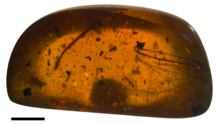
Back Бірманскі бурштын Byelorussian Birmit German Ambre de Birmanie French Ámbar birmano Galician Burmita Latin Burmiet Dutch Burmit Polish Âmbar birmanês Portuguese Бирманский янтарь Russian Burmese amber SIMPLE

Burmese amber, also known as Burmite or Kachin amber, is amber from the Hukawng Valley in northern Myanmar. The amber is dated to around 100 million years ago, during the latest Albian to earliest Cenomanian ages of the mid-Cretaceous period. The amber is of significant palaeontological interest due to the diversity of flora and fauna contained as inclusions, particularly arthropods including insects and arachnids but also birds, lizards, snakes, frogs and fragmentary dinosaur remains. The amber has been known and commercially exploited since the first century AD, and has been known to science since the mid-nineteenth century. Research on the deposit has attracted controversy due to the potential role of the amber trade in funding internal conflict in Myanmar and hazardous working conditions in the mines where it is collected.
© MMXXIII Rich X Search. We shall prevail. All rights reserved. Rich X Search